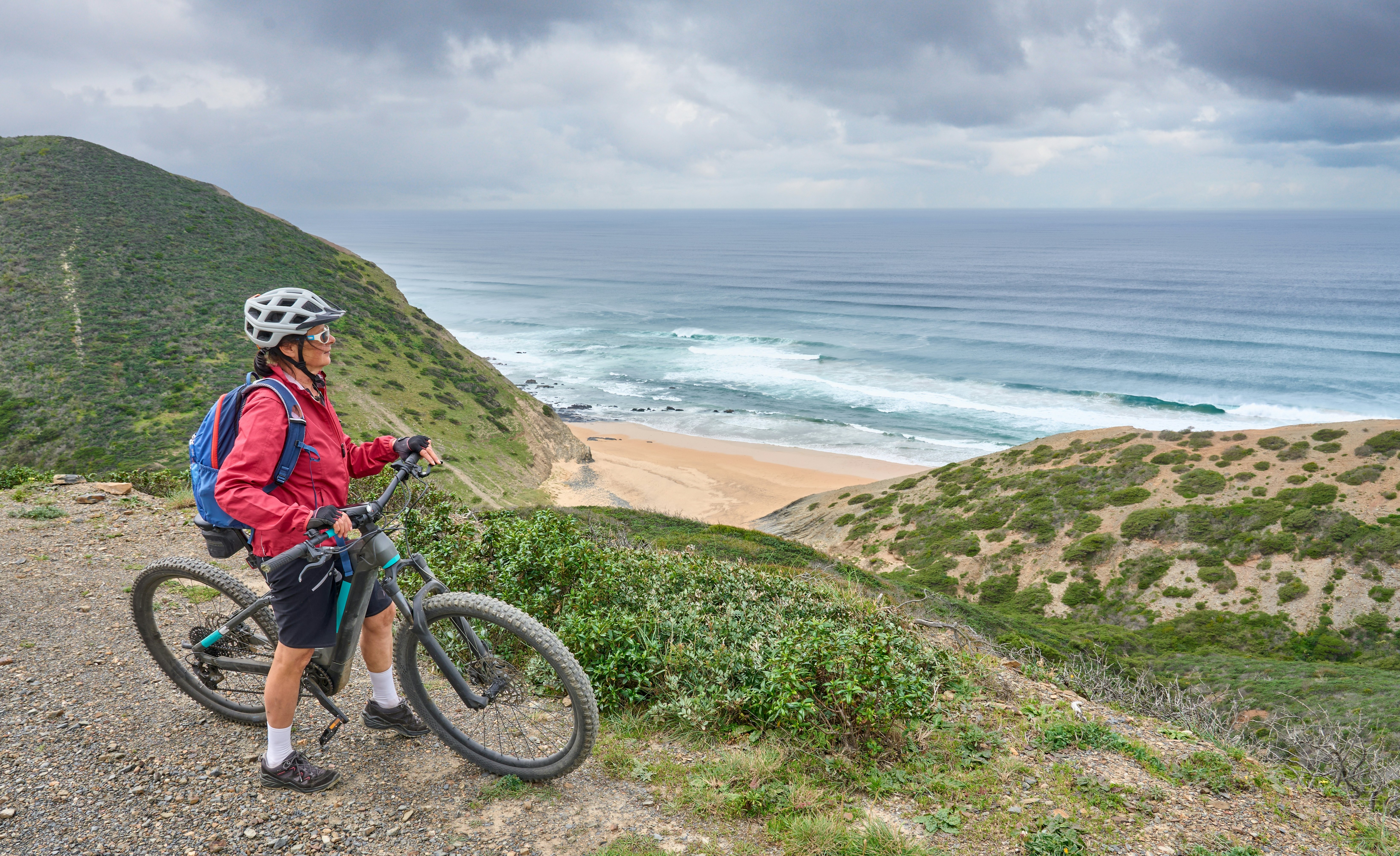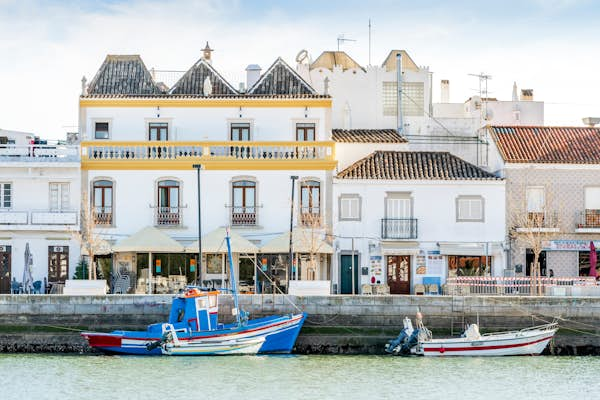Exploring the Algarve is an adventure. Ferries will transport you to idyllic sandy isles, cycle routes slice through flamingo-settled salinas (salt pans), and graffiti-adorned rail carriages casually meander between cities, orange groves and castle-crowned towns – all at affordable prices.
This is a region where slowing down to relish the scenery is almost mandatory. Rail and road infrastructure developed at a distance (and at a different pace) from the fishing villages-turned-resort towns, meaning many travelers opt to hire a car for freedom and faster connections. But with some patience and forward planning, you can reach even the tiniest hamlet by public transport, while a hiking trail can usually take you the rest of the way.

Take the train to travel between (most of) the south coast’s cities and towns
The Algarve’s aging rail carriages trundle between Lagos in the west and Vila Real de Santo António in the east. Much of the line is inland, transiting bucolic, verdant landscapes and orange groves while offering a window into the rural Algarve’s soul. While far from high-speed, the train is quicker than the bus for traveling longer distances, such as Faro to Lagos, or on city day trips, like Tavira to Olhão. Some stations, including Meia Praia and Fuseta, act as beach gateways. However, you’ll want to check the distance between the station and downtown when deciding between the bus or train. The old towns of Albufeira and Loulé, for example, are a considerable walk from their namesake stations.
Advertisement
Tickets are inexpensive. To traverse the entire line, a journey that takes over three hours (twice as long as driving via the A22) costs only €11.60 (US$13.16). There’s no advanced savings, and the CP’s Algarve-only Tourist Travelcard – two-day (€21.90; US$24.84) and three-day (€32.90; US$37.31) – is only a worthwhile investment for multiple journeys.
Tip: If there is an open ticket office at your departure station, tickets must be bought before boarding; otherwise, you’ll incur a fine. From unstaffed stations, purchase tickets onboard with the conductor (cash only). Use the CP website to buy with a card; sales stop around 15 minutes before departure.

Hire a car for a relaxed schedule and to venture inland or along the west coast
To visit the Costa Vicentina’s best beaches, meander around the Serra de Monchique’s narrow mountainous roads or hop between rural hamlets, you’ll want a car. Much of the interior, including along the border-defining Guadiana River, and the west coast only see one or two weekday buses, so driving will free you from restrictive timetables. Faro Airport has numerous hire companies (rentals are charged per 24 hours, not daily), resulting in highly affordable prices outside of the high season. For a more sustainable journey, consider an electric vehicle; keeping in mind that charging points are plentiful along the coast, but far fewer are available inland.
Just don’t expect a continuous, breezy coastal road trip. Bouncing between the south coast’s resorts and beaches nearly always requires a detour inland to the sometimes congested N125, with pretty ocean views more common beyond Burgau and around Carrapateira. The A22 highway (toll-free since 2025) allows you to cross the breadth of the region in around 90 minutes. Further inland, traffic disappears on idyllic roads, but be mindful that GPS times are optimistic – the 90 km/h limit is baffling on some of the almost one-lane roads. Slow down and enjoy the drive.
Tip: Avoid squeezing through the teeny old town roads and park on the outskirts. Always remove valuables, as tourist-targeted break-ins do happen, and avoid fake “parking attendants” who guide you to a space and then aggressively demand payment.
Use Vamus buses (and forward planning) to visit villages, beaches and smaller towns
Algarve-wide bus services and schedules have vastly improved since Vamus launched in 2021. The company operates multiple daily connections between cities, towns and some popular beaches. Smaller villages are generally only served by twice-per-weekday commuter services. During school holidays and over winter, services operate on an abridged timetable. Tickets can be purchased onboard with cash, from the desk at staffed terminais rodoviários (bus stations) or by card from new machines being rolled out at main hubs in 2025 – some routes offer online ticket sales.
Tip: The three day (€35; US$40) and seven day (€46; US$52.40) Vamus’s Tourist Pass available online are good investments if you’re planning multiple journeys. However, for the best single ticket prices (with discounts up to 40%), create a pre-pay account on the Vamus App and scan the QR code when boarding.
Advertisement

City buses are handy for reaching local sights and shorelines
For those able, walking is the best way to explore the Algarve’s urban areas – even in cities, the old towns are compact and largely pedestrianized. When you want to visit an out-of-town beach, or nearby attraction, the largely eclectic-powered municipal bus networks have better connections than Vamus. Especially useful are Faro’s Próximo services to the airport and Praia de Faro, Albufeira’s Giro for the marina or surrounding shorelines, and the Vai e Vem connections between Portimão and Praia da Rocha. Local networks also operate in Lagos (Onda) and Olhão (Cubo).
Tip: Four of the municipal networks (excluding Próximo) accept payments via the Vamus app. Single tickets and the municipal, one-operator passes, are inexpensive – buy both with cash onboard. Próximo accepts contactless payments.
Hop on a ferry for an idyllic and affordable island escape or an eclectic boat to the vineyards
Boat trips to sea caves and to see dolphins can be booked all along the south coast, but the best value ticket for a day on the Parque Natural da Ria Formosa’s sandy islands is the public ferries. The main island gateway is Olhão, while Cabanas, Faro, Fuseta and Tavira also have services to their namesake island beaches. Tickets, which cannot be prebooked, are under €5 (US$5.70) return, except for Faro’s private service to Ilha Deserta, which costs double.
Private boat trips can also take you to towns upstream along the inland waterways. Electric-powered Algarve SunBoat offers excursions from Portimão to Silves or directly to the vineyards, while Transguadiana covers the Guadiana River up to Alcoutim. Seasonal river-crossing ferries between Lagos and Meia Praia, and Portimão and Ferragudo, are handy for day’s out.
Taxis and rideshares are often the only evening option
For short distances, especially after dark when public transportation is limited, a cab or rideshare service (Bolt and Uber are the two most popular) is your best bet. All large towns and popular beach resorts have taxi stands, and cabs usually wait at terminals for trains and buses to arrive. Out-of-town drivers usually come to work on the south coast during the summer, bolstering supply, but inland and on the west coast, it’s advisable to pre-book a taxi.
Tip: During surge pricing, regular taxis are often more affordable for shorter journeys. If you take a larger, seven-seater cab at the stand, a surcharge applies regardless of the number of passengers.

Cycling will bring you closer to nature
A concerted effort is underway to make the Algarve safer and more appealing for cyclists in urban areas. New marked lanes and dedicated nature-slicing cycle ways, particularly around Tavira and Castro Marim, mean that a bike, rather than a car rental, now makes sense for local jaunts. Many of the Algarve’s shorter bike routes navigate natural settings, like flamingo-frequented salt pans or offbeat beaches, while the region-crossing Coastal Ecovia links them all (with road stretches) between Vila Real de Santo António and Cabo de São Vicente.
Tip: Bikes can be transported on trains, subject to capacity. Vamus buses officially only carry folded bikes in the luggage area, though some drivers will make exceptions.
Pack hiking boots to reach secluded, craggy shorelines and mountain lookouts
The Algarve is an excellent hiking destination outside of the hottest. Many of the region’s shorter trails, such as the beach-hopping Percurso dos Sete Vales Suspensos (Seven Hanging Valleys Trail) that climbs the cliffs between Carvoeiro, Benagil Cave and Praia da Marinha, provide an A to B alternative, easing traffic congestion and pollution around the region’s most famous coastal attractions.
You could even enjoy an almost entirely human-powered Algarve vacation. Various long-distance linear trails – the interior-crossing Via Algarviana, two west-coast traversing Rota Vicentina tracks and the roughly frontier-following Grande Rota do Guadiana – provide serene and scenic ways to explore areas inaccessible to vehicles.
Kids will love the tourist trains
In many resort towns, including Albufeira and Lagos, wheeled tourist trains can be a fun and shaded way for families to sightsee. A couple can also be handy for visiting nearby towns, such as the Carvoeiro to Ferragudo mini train. There’s even a track that will take you directly to Praia do Barril beach, crossing the lagoon wetlands just outside Santa Luzia.

For a day trip to Spain, travel by boat or kayak
If you want to cross the Guadiana River (and a timezone) to Spain for the day, save yourself the extra international car hire fee and travel by ferry instead. Boats depart from Vila Real de Santo António to Ayamonte roughly hourly during daylight hours; the 15-minute journey costs €2.30 (US$2.61). Upstream in Alcoutim, where the river narrows, it’s possible to take a boat or kayak to Spain’s Sanlúcar de Guadiana. For something different, return to Portugal by zipline.
Frequently asked questions
What’s the best way to reach Faro Airport?
The cheapest way to reach Faro Airport is to take a train or a Vamus Bus to Faro centre, and then change to Próximo Line 16; tickets cost €2.70 (US$3.06). The Vamus Aerobus 56 links Faro Airport with popular destinations like Albufeira and Lagos for €11-17 (US$12.49-19.30), though for groups of three or more, it can be cheaper to pre-book a transfer or take a taxi.
Do tourist attractions offer shuttles?
Some Algarvian water and theme parks offer shuttle buses. For example, when booking Slide & Splash tickets online, there’s an option to include an Albufeira pickup.
Can you buy a combined bus and rail pass?
The two main tourism transport passes in the Algarve are the Vamus Bus Pass and CP Tourist Travelcard; there isn’t a train and bus combo ticket.
Are strikes common on the Algarve railway?
Strikes on the Algarve Railway Line happen occasionally. Thankfully, there is usually advance notice so you can plan around them. Monitor CP Alerts for upcoming disruptions.
Accessible transportation in the Algarve
In some areas, the Algarve excels in accessibility. Nearly 50 beaches now have boardwalks and ramps; some providing amphibious wheelchairs (during lifeguard season, June to September). Visit Portugal has created a handful of accessible city-tour routes – Portimão’s flat, street-art decorated pathway being one example. Nearly all city buses (not Vamus) are wheelchair accessible, with low floors and ramps, and some have auditory cues when approaching stops. If you want to get out on the water, Ria Formosa Boat Tours run trips with a customized, wheelchair-accessible vessel with a water hoist.
However, traveling around the region remains challenging. The cobblestone pavements are often bumpy or too narrow, and Vamus’ buses are all coaches, meaning access is only via stairs. The regional rail line also lacks service provisions, and although many stations’ platforms were raised in 2024, access to the carriages still requires the use of stairs. CP does provide prebooked assistance for boarding rail services; however, nearly all Algarve stations are excluded. The exceptions are Tunes and Faro, where support is provided for the Alfa Pendular trains traveling to Lisbon.

